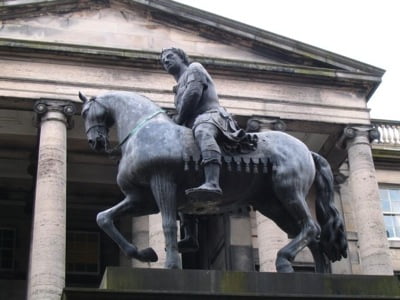Charles II off for a haircut
 The famous statue of Charles II in Parliament Square, Edinburgh, was taken away for specialist conservation yesterday (Sunday 24 October 2010).
The famous statue of Charles II in Parliament Square, Edinburgh, was taken away for specialist conservation yesterday (Sunday 24 October 2010).
It is the oldest equestrian lead statue in the UK, dating back to 1685, and is possibly the work of the Dutch sculptor Grinling Gibbons.
The work is the latest installment of the on-going Twelve Monuments Restoration Project, a joint initiative by the City of Edinburgh Council and Edinburgh World Heritage.
The imposing monument is made of lead and has an internal framework, made from oak and mild steel. Over time this has deteriorated, putting stress on the statue and causing cracks in the lead.
Councillor Ron Cairns, Vice Convenor of the Culture and Leisure Committee, said: “This majestic statue is the oldest in Edinburgh, occupying a prime position in Parliament Square at the heart of the Old Town. By restoring it to its former glory, we will be preserving a significant Edinburgh landmark for future generations.”
Adam Wilkinson, Director of Edinburgh World Heritage said: “The statue of Charles II is utterly beguiling, far from the pomposity of his father’s statue in Trafalgar Square in London. This is the monarch of a different kind of a nation, following the trauma and upheaval of the Commonwealth, seeking calm authority. Statuary is one of the aspects of the World Heritage Site that is easily forgotten, yet which plays an important part in creating the drama of some of our public spaces, in this case Parliament Square behind St Giles. We are delighted to be supporting the repair of this important statue, which is the first in a long line of important public monuments in Edinburgh and the story it has to tell.”
After a painstaking process to remove it safely from its plinth, the Charles II statue was due to be transported to the Rochester studio of Hall Conservation Ltd for specialist conservation work. There it will be carefully taken apart and rebuilt, supported by a new internal stainless steel frame. The lead will be cleaned and missing parts such as the sword and scabbard replaced, modelled on a similar statue at Windsor Castle.
The work is being funded by the City of Edinburgh Council and Edinburgh World Heritage, along with donations from the Scottish Court Service, the High Constables of Edinburgh and many private donors.
The conservation work is expected to take six months, with the statue returned to its former glory in spring 2011.